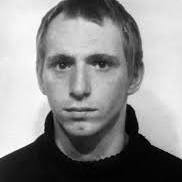
b: 1960
Bruce George Peter Lee
Summary
Name:
Nickname:
Daft PeterYears Active:
1973 - 1979Birth:
July 31, 1960Status:
ImprisonedClass:
Serial KillerVictims:
12Method:
ArsonNationality:
United Kingdom
b: 1960
Bruce George Peter Lee
Summary: Serial Killer
Name:
Bruce George Peter LeeNickname:
Daft PeterStatus:
ImprisonedVictims:
12Method:
ArsonNationality:
United KingdomBirth:
July 31, 1960Years Active:
1973 - 1979Date Convicted:
January 20, 1981bio
Bruce George Peter Lee was born as Peter George Dinsdale on July 31, 1960, in Manchester, England. His mother was a sex worker, and he did not have a stable family life. He was raised in children's homes, which meant he spent most of his early life away from his biological family.
From a young age, Lee faced health challenges. He had epilepsy, which is a condition that causes seizures. Additionally, he was born with congenital spastic hemiplegia, which affected the movement of his right limbs. As a result, he walked with a limp on his right leg and had a habit of holding his right arm across his chest.
Lee worked as a laborer and was known in his community as "Daft Peter," a name that reflected how others viewed him. In 1979, his mother remarried a man with the surname Lee. That same year, Peter decided to change his name by deed poll to Bruce George Peter Lee, in part to pay homage to the martial artist Bruce Lee. Later, he would change his name again and become known as Peter Tredget.
murder story
On December 4, 1979, a fire started at a house on Selby Street in Hull, England. Inside the home were Edith Hastie and her four sons: Thomas, Charles, Paul, and Peter. At the time, the family was asleep. Charles was able to save his mother by pushing her out of an upstairs window. Unfortunately, he could not help his younger brothers, Paul and Peter, who were trapped in the same bedroom. They suffered severe burns and were taken to a specialist burns unit. Charles died soon after the fire, followed by Peter two days later, and Paul after twelve days. Thomas, who had muscular dystrophy, managed to escape through a window in another room.
The local police established a makeshift incident room to investigate the fire. They found it surprising that the neighbors appeared indifferent to the tragedy. This indifference became evident at the joint funeral of the boys, where their mother expressed her frustration over the lack of sympathy. The authorities thought the Hastie family might have been targeted for revenge due to their reputation in the community.
Bruce George Peter Lee was one of many teenagers who came forward to help police with their inquiries. Six months later, he confessed to setting the fire. Lee explained that he had poured paraffin through the letterbox and ignited it as revenge against Charles Hastie, with whom he claimed to have had sexual contact. He mentioned that Charles had threatened to notify the police unless Lee paid him money. Lee was also infatuated with Charles's sister, Angeleena, who had rejected him.
During the investigation, Lee admitted to starting nine more fatal fires over the past seven years. At this time, authorities learned that a total of 26 people had died in these fires, which included different victims ranging from infants to elderly men in a residential home. Lee described starting these fires mostly for his enjoyment of fire, without considering the potential danger to life.
Police officers took Lee around Hull to show them the sites of the fires he had admitted to starting. They confirmed that fires had indeed been set at those locations. Lee later expressed some remorse for the casualties but stated that he had not intended to kill anyone when he started most of the fires.
On January 20, 1981, Lee faced trial. He pleaded not guilty to 26 counts of murder but guilty to 26 counts of manslaughter, claiming diminished responsibility. He received an indefinite hospital detention and was sent to Park Lane Special Hospital. In 1983, a public inquiry found that he was not responsible for one high-profile fire that had resulted in multiple deaths.
Over the years, Lee's confessions were questioned. He recanted and maintained his innocence. In 2021, a new appeal was made, arguing that he had falsely confessed due to his mental health issues. By 2022, the Court of Appeal acquitted him of some counts but upheld others.